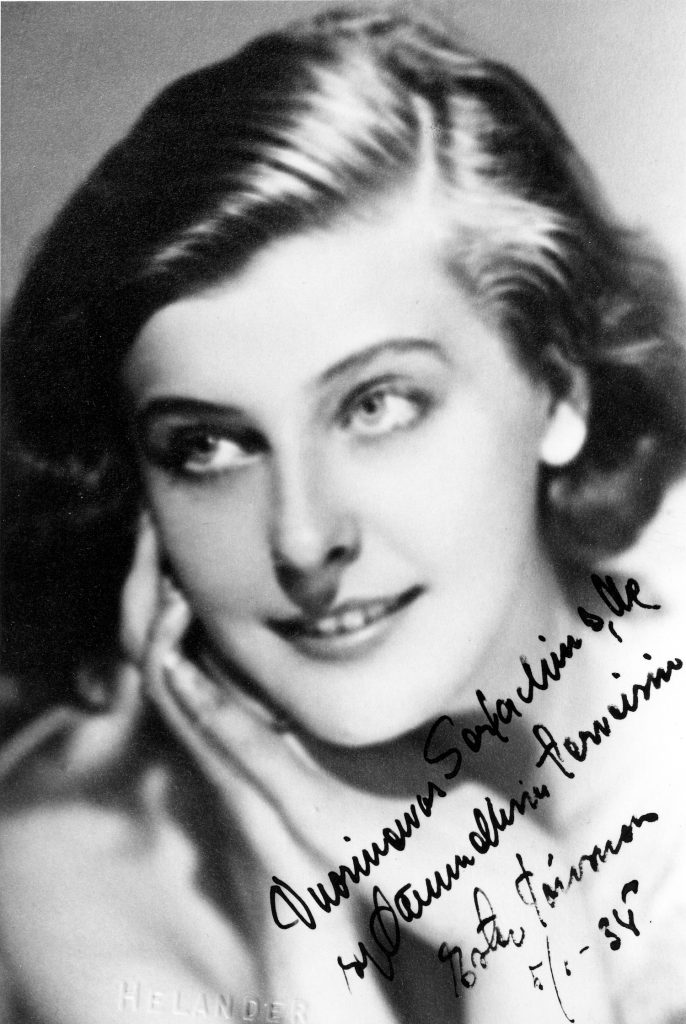Ester Toivonen’s photograph from the year 1934
Miss Europe 1934, Ester Toivonen (1914–1979), was a frequently seen guest in Mänttä between 1935–1938. When Gösta and Ruth Serlachius met young Ester in 1934, the spouse of the mill owner who was then 52 years old began to call her daughter, and at the request of the 58-year-old industrialist, Ester, according to the custom of the era, began to call him uncle.
Before becoming a Miss, Ester had worked as a saleswoman at Elanto in Helsinki. Being a Miss changed her life. Under the guidance of the Serlachius couple, she acquainted herself with the social etiquette of the so-called wider world, its codes of behaviour, ways of dressing, etc. In her own words, during her first period as a Miss, she “wasn’t yet ready for anything”.
In the Picture Archive of G. A. Serlachius Ltd, there is a photo of Ester Toivonen taken for a soap advertisement, on which the beauty has written a dedication to “Mill owner Serlachius, with my most affectionate greetings Ester Toivonen June 5 1934”. According to Toivonen’s biography, the acquaintanceship between her and industrialist Serlachius was a result of the advertisement bureau Erva-Latvala’s having transmitted the request for Miss Europe to come to Mänttä in order to have her portrait painted. Her first visit dates to the end of 1934, when the immigrant painter Georges von Swetlik (1912–1991) who had been born in St. Petersburg started to paint the portrait of Miss Europe.
G. A. Serlachius Ltd, led by Gösta Serlachius, was a client of the bureau Erva-Latvala. The same bureau had since the autumn of 1934 been handling the contract and advertisement matters of Miss Europe. Serlachius afterwards commented that it would have taken only three days to make the sketches for the portrait, if he and his wife hadn’t liked Ester Toivonen. Their acquaintanceship developed into a friendship and the Serlachius’s home became a second home for Ester Toivonen, a place for rest and escape, during the following 3–4 years.
In the spring of 1935, the trio took a trip together to Europe and North Africa. Toivonen had agreements made for advertisement photos being taken of her in Holland, and the Serlachius couple combined their spring trip with hers in such a way that from Holland the journey first continued to Berlin, where Miss Europe at a museum stood face to face with a beauty of her own calibre, the sculpture of Nefertiti. Next in turn were Milan, Genoa, Monte Carlo and Nice. From Marseille they continued by ship to Casablanca in Morocco and from there to Marrakesh, Fez and Rabat. The journey back went via Lisbon first to Paris and then London, where Ester Toivonen stayed in order to study English.
Having studied German at school, she needed to learn English, since she was dreaming of a career as a movie star in Hollywood. Ester Toivonen never became an international movie star, but between 1934–1943 she performed in fourteen films made by Suomi-filmi. In the correspondence of Gösta Serlachius, film contracts made between Ester Toivonen and Suomen Filmiteollisuus (SF) have been preserved.
In 1933, after Ester Toivonen had been selected Miss Finland, she met her future husband, the officer candidate Eero Sirelius (later Siirala) from Viipuri, whom she married and with whom she had two children. Her friendship with the Serlachius couple lasted as long as Gösta and Ruth Serlachius lived, even though Toivonen rarely visited Mänttä after 1938.
Marjo-Riitta Simpanen
Curator


